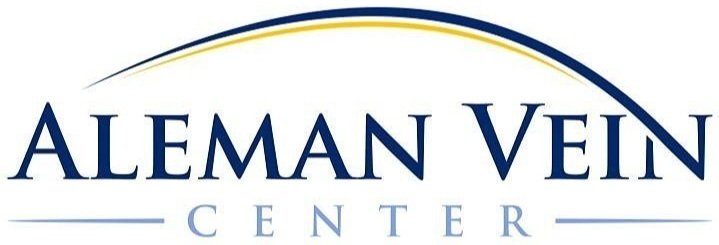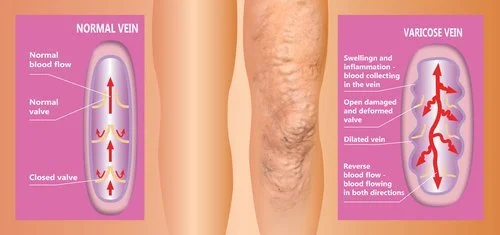
What are Varicose Veins and Spider Veins?
What Causes Varicose Veins?
Varicose vein disease, or venous insufficiency, is both chronic and progressive. It is a common misconception that vein disease is limited to spider veins or unsightly varicose veins. The reality is that it often progresses beyond the early stages and can cause significant health issues or complications.
Why do we get varicose veins?
Veins have one-way valves, or check valves, inside of them. These valves are critically important to the function of the veins as they direct the flow of blood upwards towards the heart and against gravity. The underlying issue with venous insufficiency is usually that these valves begin to fail. Once the valves fail, the “dirty” blood that is depleted of oxygen and full of waste products of metabolism begins to flow backwards with gravity back down the leg and up to the surface. This abnormal flow, referred to as venous reflux, causes the veins to dilate and become visible as spider veins and varicose veins.
The most important risk factor for developing varicose vein disease is genetics. It has been estimated that one parent with vein disease raises your risk for vein disease to 40%. If both parents have vein disease, your risk rises to about 80%. In addition, the following risk factors may also contribute.
Age
Female Gender
Pregnancies
Obesity
Prolonged sitting or standing
The Stages of Varicose Vein Disease
Stage 1 - Spider Veins
Many people start with cosmetic concerns about unsightly spider veins. When abundant, they may cause itching and burning. Larger spider veins may be prone to bleeding, especially in patients on blood thinners.
Stage 2 - Varicose Veins
The second stage is larger failed veins referred to as varicose veins. These veins are frequently seen bulging at the skin surface. It is during this stage that many people begin to feel the symptoms of varicose veins, such as deep leg aching, pain, throbbing, heaviness, fatigue, restless legs, and leg or foot cramping at night. Importantly, they are not always visible because they are located deeper than the skin surface. Many people feel varicose veins before they see them. Unfortunately, many people mistakenly blame these symptoms to other things, such as dehydration, standing on hard floors, or aging.
Treatment at this stage may be warranted for either cosmetic concerns or for relief of symptoms.
Stage 3 - Leg Swelling
Leg swelling, or leg edema, is a common symptom of vein disease. Swelling can have many causes and they often overlap. Swelling indicates an accumulation of fluid in the lower leg that typically worsens throughout the day. Evaluation by a vein specialist for the presence of venous reflux is usually indicated at this stage. Recently, swelling has been implicated in the development of secondary lymphedema, or Phlebolymphedema.
Stage 4 - Venous Stasis Dermatitis, Leg Rashes and Discoloration
Over time, the “dirty blood” pooling in failed veins near the skin surface can trigger inflammation and rashes at this skin surface. This is termed Venous Stasis Dermatitis. It is not uncommon that we see patients with this condition who have been inadequately treated with steroids applied to the skin surface. When it doesn’t improve or it returns, they sometimes think that there is nothing else to do and let their venous insufficiency worsen.
At this stage, venous insufficiency should be treated by a vein specialist in order to prevent progression to permanent skin discoloration termed Hyperpigmentation. Hyperpigmentation is caused by the break down of red blood cells that leak out of capillaries and leave iron at the surface. In severe cases, the tissue beneath the skin may begin to scar and cause a sunken appearance that indicates lipodermatosclerosis.
Stage 5 - Venous Stasis Ulcer
This is the end stage complication of chronic venous insufficiency. These wounds are typically located in the lower leg just above the ankle bones. Ideally, venous ulcers should be prevented by treating at an earlier stage of disease. If an ulcer is present, it is critically important to have the vein disease treated as soon as possible.








